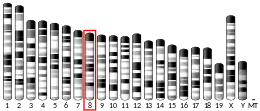KCNK1
Potassium channel subfamily K member 1 is a protein that in humans is encoded by the KCNK1 gene.[5][6][7]
This gene encodes K2P1.1, a member of the superfamily of potassium channel proteins containing two pore-forming P domains. The product of this gene has not been shown to be a functional channel, however, and it may require other non-pore-forming proteins for activity.[7]
See also
- Tandem pore domain potassium channel
References
- GRCh38: Ensembl release 89: ENSG00000135750 - Ensembl, May 2017
- GRCm38: Ensembl release 89: ENSMUSG00000033998 - Ensembl, May 2017
- "Human PubMed Reference:". National Center for Biotechnology Information, U.S. National Library of Medicine.
- "Mouse PubMed Reference:". National Center for Biotechnology Information, U.S. National Library of Medicine.
- Lesage F, Mattei M, Fink M, Barhanin J, Lazdunski M (Dec 1996). "Assignment of the human weak inward rectifier K+ channel TWIK-1 gene to chromosome 1q42-q43". Genomics. 34 (1): 153–5. doi:10.1006/geno.1996.0259. PMID 8661042.
- Goldstein SA, Bayliss DA, Kim D, Lesage F, Plant LD, Rajan S (Dec 2005). "International Union of Pharmacology. LV. Nomenclature and molecular relationships of two-P potassium channels". Pharmacol Rev. 57 (4): 527–40. doi:10.1124/pr.57.4.12. PMID 16382106. S2CID 7356601.
- "Entrez Gene: KCNK1 potassium channel, subfamily K, member 1".
Further reading
- Goldstein SA, Wang KW, Ilan N, Pausch MH (1998). "Sequence and function of the two P domain potassium channels: implications of an emerging superfamily". J. Mol. Med. 76 (1): 13–20. doi:10.1007/s109-1998-8100-0. PMID 9462864.
- Lesage F, Lazdunski M (2000). "Molecular and functional properties of two-pore-domain potassium channels". Am. J. Physiol. Renal Physiol. 279 (5): F793–801. doi:10.1152/ajprenal.2000.279.5.F793. PMID 11053038.
- Goldstein SA, Bockenhauer D, O'Kelly I, Zilberberg N (2001). "Potassium leak channels and the KCNK family of two-P-domain subunits". Nat. Rev. Neurosci. 2 (3): 175–84. doi:10.1038/35058574. PMID 11256078. S2CID 9682396.
- Lesage F, Guillemare E, Fink M, et al. (1996). "TWIK-1, a ubiquitous human weakly inward rectifying K+ channel with a novel structure". EMBO J. 15 (5): 1004–11. doi:10.1002/j.1460-2075.1996.tb00437.x. PMC 449995. PMID 8605869.
- Lesage F, Reyes R, Fink M, et al. (1997). "Dimerization of TWIK-1 K+ channel subunits via a disulfide bridge". EMBO J. 15 (23): 6400–7. doi:10.1002/j.1460-2075.1996.tb01031.x. PMC 452465. PMID 8978667.
- Orias M, Velázquez H, Tung F, et al. (1997). "Cloning and localization of a double-pore K channel, KCNK1: exclusive expression in distal nephron segments". Am. J. Physiol. 273 (4 Pt 2): F663–6. doi:10.1152/ajprenal.1997.273.4.F663. PMID 9362344.
- Wang Z, Yue L, White M, et al. (1999). "Differential distribution of inward rectifier potassium channel transcripts in human atrium versus ventricle". Circulation. 98 (22): 2422–8. doi:10.1161/01.cir.98.22.2422. PMID 9832487.
- Medhurst AD, Rennie G, Chapman CG, et al. (2001). "Distribution analysis of human two pore domain potassium channels in tissues of the central nervous system and periphery". Brain Res. Mol. Brain Res. 86 (1–2): 101–14. doi:10.1016/S0169-328X(00)00263-1. PMID 11165377.
- Strausberg RL, Feingold EA, Grouse LH, et al. (2003). "Generation and initial analysis of more than 15,000 full-length human and mouse cDNA sequences". Proc. Natl. Acad. Sci. U.S.A. 99 (26): 16899–903. doi:10.1073/pnas.242603899. PMC 139241. PMID 12477932.
- Nicolas MT, Barhanin J, Reyes R, Demêmes D (2004). "Cellular localization of TWIK-1, a two-pore-domain potassium channel in the rodent inner ear". Hear. Res. 181 (1–2): 20–6. doi:10.1016/S0378-5955(03)00162-X. PMID 12855359. S2CID 23605830.
- Ota T, Suzuki Y, Nishikawa T, et al. (2004). "Complete sequencing and characterization of 21,243 full-length human cDNAs". Nat. Genet. 36 (1): 40–5. doi:10.1038/ng1285. PMID 14702039.
- Gerhard DS, Wagner L, Feingold EA, et al. (2004). "The status, quality, and expansion of the NIH full-length cDNA project: the Mammalian Gene Collection (MGC)". Genome Res. 14 (10B): 2121–7. doi:10.1101/gr.2596504. PMC 528928. PMID 15489334.
- Rajan S, Plant LD, Rabin ML, et al. (2005). "Sumoylation silences the plasma membrane leak K+ channel K2P1". Cell. 121 (1): 37–47. doi:10.1016/j.cell.2005.01.019. PMID 15820677. S2CID 6314155.
- Rual JF, Venkatesan K, Hao T, et al. (2005). "Towards a proteome-scale map of the human protein-protein interaction network". Nature. 437 (7062): 1173–8. doi:10.1038/nature04209. PMID 16189514. S2CID 4427026.
External links
- KCNK1+protein,+human at the US National Library of Medicine Medical Subject Headings (MeSH)
This article incorporates text from the United States National Library of Medicine, which is in the public domain.
This article is issued from Wikipedia. The text is licensed under Creative Commons - Attribution - Sharealike. Additional terms may apply for the media files.




